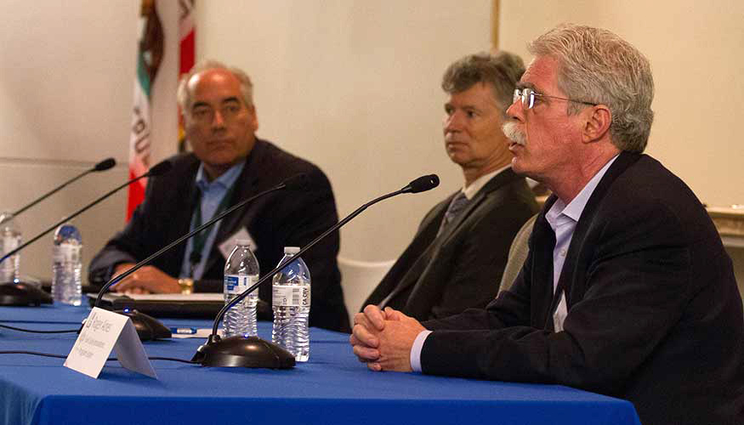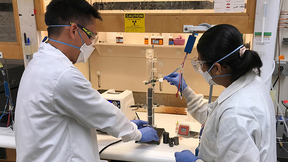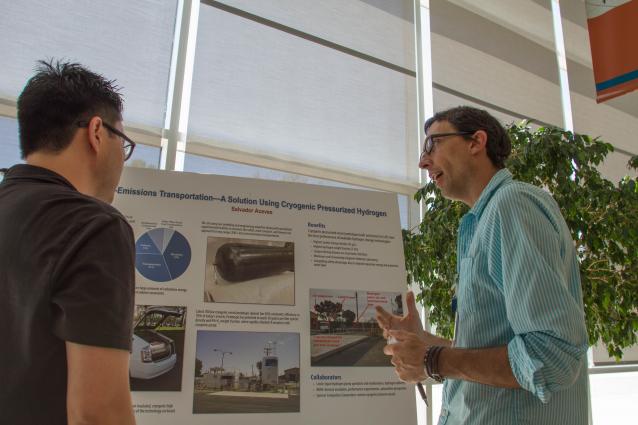Lab, industry take charge of clean energy
 (Download Image)
Roger Aines (right), a geochemist who runs the Lab’s Carbon Fuel Cycle Program, discusses a carbon capture technique using microcapsules during a panel discussion at Lawrence Livermore. Photos by Julie Russell/LLNL
(Download Image)
Roger Aines (right), a geochemist who runs the Lab’s Carbon Fuel Cycle Program, discusses a carbon capture technique using microcapsules during a panel discussion at Lawrence Livermore. Photos by Julie Russell/LLNL
Lawrence Livermore National Laboratory officials met with energy industry representatives Tuesday to discuss ways in which the two entities can work more closely.
The event highlighted a public-private partnership to engage energy storage companies with LLNL’s world-class research capabilities and facilities through the CalCharge consortium.
During a daylong open house, energy storage industry leaders and innovators as well as Lab officials explained how they will work together to drive research and development of clean energy technologies. New green technologies from Lawrence Livermore, Lawrence Berkeley and SLAC National Accelerator also were on display during a poster session.
CalCharge is an energy storage consortium that is accelerating innovation and commercialization of battery technology with emerging and established companies, academic and research institutions, government bodies and financing sources.
"We want to spin out our discoveries and innovations to industry so that they will have an impact on the well-being of the United States," LLNL Director Bill Goldstein said.
CalCharge and Lawrence Livermore are in the process of working out a standard cooperative research agreement that would allow CalCharge members access to Lawrence Livermore’s world-class scientists and facilities. The agreement, known as a Collaborative Research and Development Agreement (CRADA), complements CalCharge CRADAs already in place with Lawrence Berkeley and SLAC National Accelerator Laboratory. The CRADA streamlines the process for industries looking to partner with the national laboratories.
Energy storage is considered key to the broad uptake of clean energy technologies throughout the economy, from transportation to the power sector to consumer electronics. The resources available at the three institutions could help spur dramatic improvements in advanced energy storage manufacturing.
"Our labs are so busy doing things that they forget to tell the world about it," said Joyce Losick-Yang, of the Department of Energy’s Office of Energy Efficiency and Renewable Energy. "The national laboratories are an incredible powerhouse of science and engineering. They develop incredible solutions for national and industry challenges."
Lawrence Livermore‘s current energy storage research ranges from electromechanical batteries to 3D-printed graphene aerogels to lithium-based batteries with improved power densities and safety characteristics. Industry representatives toured the National Ignition Facility and learned more about the Laboratory’s work in the energy sector during panel discussions and briefings on the Lab’s computation and engineering capabilities.
"Partnerships are how we operate at the Laboratory," said Doug Rotman, head of the lab’s energy department. "You (industry) know best what the technological needs are and we want to bring that technology to the marketplace."
See more photos of the CalCharge consortium on Flickr.
Contact
 Anne M. Stark
Anne M. Stark
[email protected]
(925) 422-9799
Related Links
CalChargeLLNL’s Atmospheric, Earth, and Energy Division
More photos on Flickr
Tags
Economic ImpactIndustry Collaborations
Technology Transfer
Featured Articles








